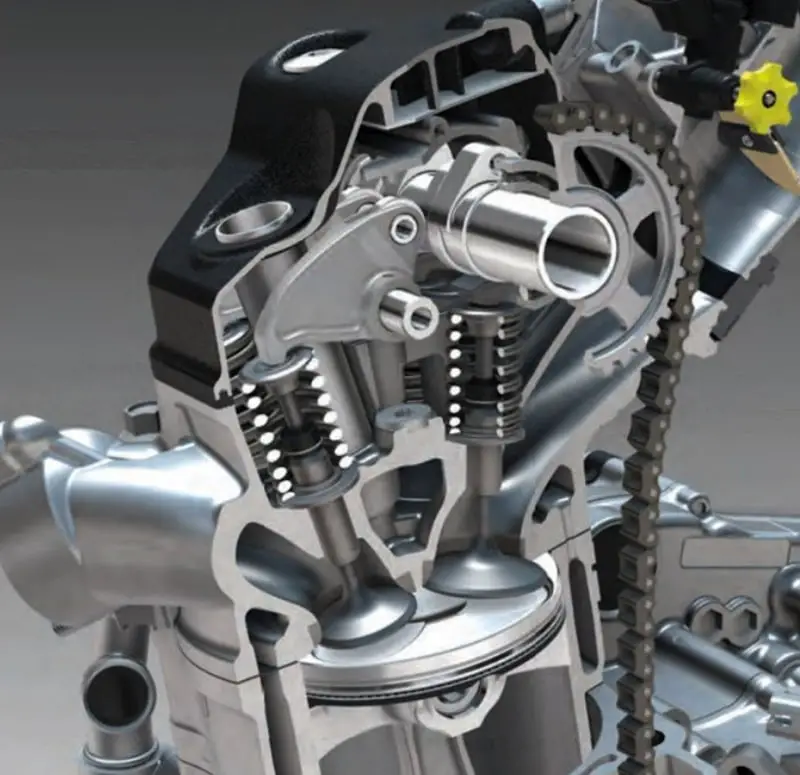ASK THE MXPERTS: “WHAT IS A DOHC? HOW IS IT DIFFERENT FROM OTHER ENGINES?”
 Honda’s DOHC 2018-19 CRF250 engine features two cams that activate finger followers, which activate the valves.
Honda’s DOHC 2018-19 CRF250 engine features two cams that activate finger followers, which activate the valves.
DOHC VERSUS SOHC VERSUS NFL VERSUS AFL-CIO
Dear MXA,
What is a DOHC? How does the 2018 Honda CRF250 DOHC engine differ from the 2017 engine?
The 2018 CRF250 is a DOHC engine and the 2017 Honda CRF250 is a SOHC engine. DOHC stands for “double overhead cam,” while SOHC stands for “single overhead cam.” The most obvious difference between the two engines is the number of cams. On the older single-overhead-cam engine, there is only one cam to control both the intake and exhaust valves. Honda’s Uni-Cam design activates two intake valves by having the lobes on the cam directly push on them, while a forked rocker arm actuates the two exhaust valves from a third lobe on the cam. The benefit of this is less rotating mass in the cylinder head, a more compact design and lighter weight. The downside of the Uni-Cam engine is that a rocker arm hampers high-rpm performance and isn’t conducive to big valves and lots of lift. With dedicated cams for exhaust and intake function, the DOHC engine can spin faster, open the valves higher and be easily tuned with different lobe shapes. The downside of a double-overhead-cam engine is that it is heavier, bulkier and feeds more gyroscopic effect into the chassis.
 The 2017 Honda CRF450 Uni-Cam SOHC engine. The single cam has lobes that operate two valves, while rocker arms activate the other two.
The 2017 Honda CRF450 Uni-Cam SOHC engine. The single cam has lobes that operate two valves, while rocker arms activate the other two.
How you open and close the valves, while a very important feature of any engine, is really less significant in action than the valves themselves. The 2018 Honda CRF250 has bigger valves than the 2017 edition. Honda bumped up the valve diameter on both the intake and exhaust side—from 30.5mm to 33mm on the intakes and from 25mm to 26mm for the exhaust. Not only are the CRF250’s valves bigger, they open up wider—from 9.2mm to 10.5mm of lift on the intake valves and from 8.4mm to 9.5mm of lift on the exhaust valves.
In conjunction with the two cams, bigger valves and more lift, the 2018 CRF250 engine has a bigger bore and a shorter stroke. The short-stroke design allows the 2018 CRF250 to rev higher, which the bigger valves and increased lift demand in order to process the added fuel coming into the head. Compared to the 2017 CRF250 engine, the stroke is reduced by 2.9mm and the bore is bumped up 2.2mm. The rev limit was raised by 900 rpm over 2017, while peak horsepower was moved up 2000 rpm. Equally important was the change from a single exhaust port to dual exhaust ports and twin exhaust pipes—one down the right side of the bike and one down the left The final touch was to add electric starting.
Sadly, all of these changes on the 2018 Honda CRF250 were less than effective. The cumulative impact was a total lack of low-end power and a midrange that was 4 horsepower less than on the 2017 CRF250. Although there is more peak horsepower, it has a very narrow sweet spot (from 10,000 rpm to 12,000 rpm) and is followed by a flat overrev that sounds like the engine is coming apart. It is a very peaky four-stroke and suffers from bogging and stalling. When you add in the fact that the 2018 CRF250 is the heaviest 250 on the showroom floor at 228 pounds, you have to question the viability of the 2018 CRF250’s engine R&D program.
Honda, for their part, has reconfigured the power outputs of the 2019 Honda CRF250 to fix the flaws in their top-end only engine.





Comments are closed.